
Low dropout (LDO) linear regulators have been widely used in noise-sensitive applications for decades. However, the latest precision sensors, high-speed and high-resolution data converters (ADCs and DACs), and frequency synthesizers (PLL/VCOs) continue to challenge traditional LDO regulators to produce ultra-low output noise and ultra-low output noise. With high power supply ripple rejection (PSRR), noise requirements become increasingly difficult to meet. For example, when powering a sensor, power supply noise can directly affect the accuracy of the measurement results. Switching regulators are often used in power distribution systems to achieve higher overall system efficiency. To build a low-noise power supply, LDO regulators typically post-regulate the output of a relatively noisy switching converter without the need for bulky output filter capacitors. The high-frequency PSRR performance of the LDO regulator becomes critical.
The LT3042, launched in 2015, is the industry's first linear regulator with
only 0.8μVrms output noise and 79dBPSRR at 1MHz. Two similar devices, the
LT3045 and LT3045-1, offer higher ratings and additional features. All these
devices are positive LDO regulators. When the system has bipolar devices
such as op amps or ADCs, a negative LDO regulator must be used in the polar
power supply design. The LT3094 is the first negative LDO regulator with
ultra-low output noise and ultra-high PSRR. Table 1 lists the key features
of the LT3094 and related devices.
typical application
The LT3094 features a precision current source reference followed by a
high-performance output buffer. The negative output voltage is programmable
with a -100µA precision current source through a single resistor. This
current-reference-based architecture provides a wide output voltage range
(0V to -19.5V) and provides nearly constant output noise, PSRR, and load
regulation regardless of the programmed output voltage. Figure 1 shows a
typical application, and the demo board is shown in Figure 2. The overall
solution size is approximately only 10mm x 10mm.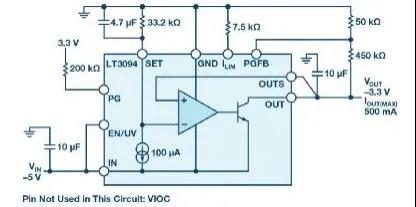
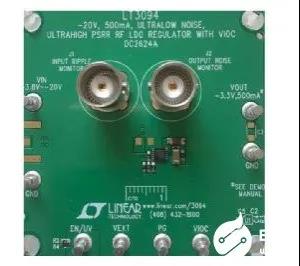
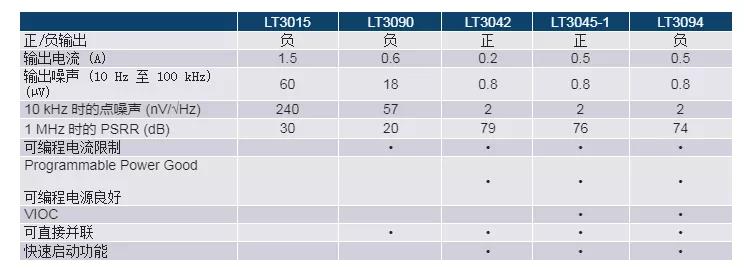
The LT3094 features ultra-low output noise of 0.8µVrms from 10Hz to 100kHz and
an ultra-high PSRR of 74dB at 1MHz. In addition, the LT3094 features
programmable current limit, programmable power-good threshold, fast-start
function and programmable input-to-output voltage control (VIOC). When the
LT3094 post-regulates the switching converter, if the LDO regulator output
voltage is variable, the voltage across the LDO regulator will be kept constant
through the VIOC function.
The LT3094 protects against device damage through internal protection features,
including internal current limit with foldback, thermal limit, reverse current
and reverse voltage protection.
Direct parallel connection for higher current
The LT3094 can be easily paralleled to increase output current. Figure 3 shows a
solution using two LT3094s connected in parallel to achieve 1A output current.
To connect two devices in parallel, connect the SET pins together and place a
SET resistor RSET between the SET pin and ground. The current flowing through
RSET is 200µA, which is twice the amount of SET current in a single device. In
order to obtain good current sharing characteristics, each output of the LT3094
uses a small current resistor of 20mΩ.
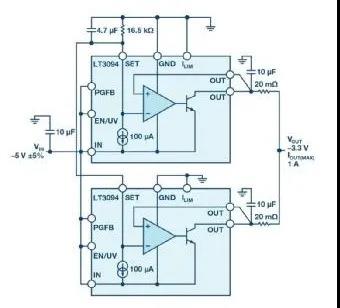
Figure 4 shows the thermal performance of the circuit in Figure 3 with an input voltage of −5V and an output voltage of −3.3V, operating at 1A load current. The temperature of each device rose to approximately 50°C, indicating even heat distribution. For higher output current and lower output noise, there is no limit to the number of devices that can be connected in parallel.
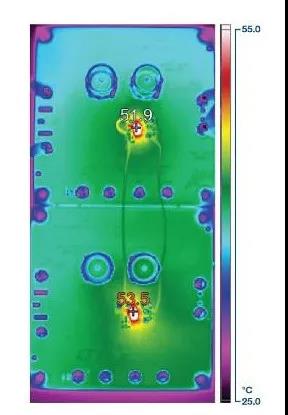
Positive and negative dual power supplies with
variable output voltage
The power supply is usually configured with a switching converter post-regulated
by an LDO regulator to achieve low output noise and high system efficiency. To
maintain a proper trade-off between power consumption and PSRR, the optimal
voltage difference between the input and output of the LDO regulator is
approximately -1V. Maintaining this voltage difference in a variable output
voltage system is complicated, but the LT3094 has a tracking function VIOC that
keeps the voltage constant across the LDO regulator even if the output voltage
changes.
(1) Where VFBX2 is 0mV and IFBX is 83.3µA. Setting R2 to 14.7kΩ sets the VIOC
voltage to 1.23V for a variable output voltage. When resistor R1 is 133kΩ,
limiting the input voltage of LT3094 to 16.5V, the calculation is as follows
(2) The thermal image of the circuit operating under 12V input is shown in
Figure 6. When the output voltage changes from ±3.3V to ±12V, the temperature
rise of the LT3094 remains constant. Table 2 lists the voltage and current for
all three devices. Figure 7 shows the ±5V supply transient response at a 12V
input.
In Figure 5, no additional capacitance is placed at the input of the LT3094
other than the output capacitance of the LT8582. Normally, input capacitance
reduces output ripple, but this is not the case with the LT3094. If the LT3094
has an input capacitor, the switching converter's switching current will flow
through the input capacitance, causing electromagnetic coupling of the switching
converter to the LT3094 output. Output noise will increase, causing PSRR to
decrease. If the switching regulator is located within two inches of the LT3094,
for best PSRR performance we recommend not placing capacitors at the input of
the LT3094.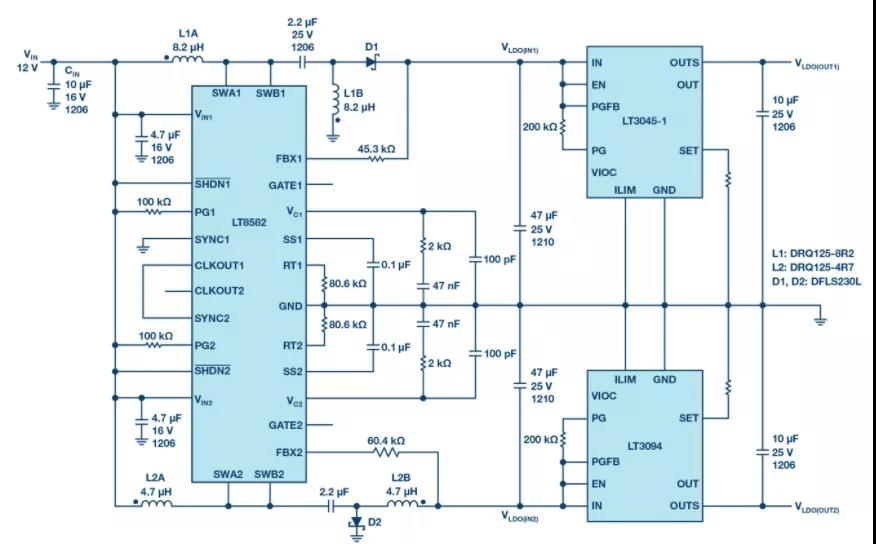
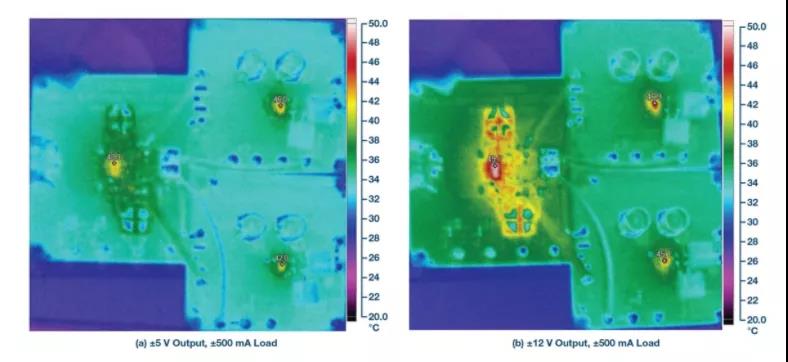
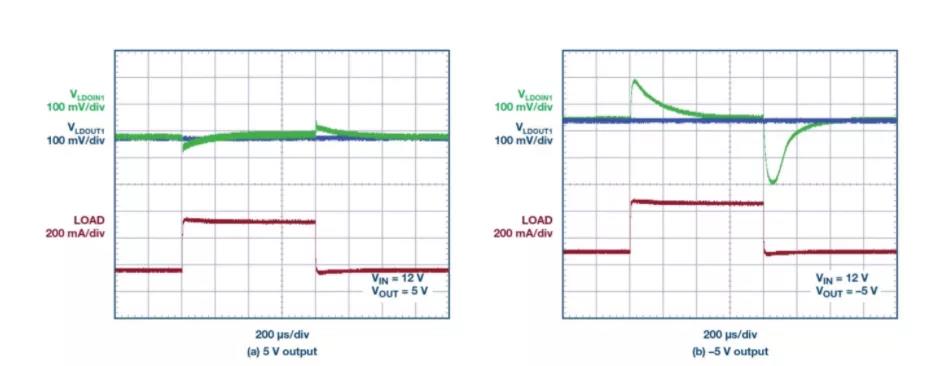

in conclusion
The LT3094 is a negative LDO regulator with ultra-low noise and ultra-high
PSRR. It uses a current reference-based architecture that makes noise and
PSRR performance independent of output voltage, and multiple LT3094s can be
easily paralleled to increase load current and reduce output noise. When the
LT3094 is used to post-regulate a switching converter, the VIOC feature can
minimize the power consumption of the LDO regulator, making it ideal for
variable output voltage applications.